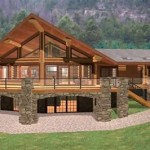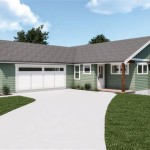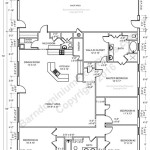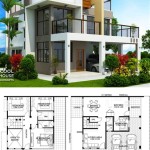Exploring Free Tiny Home Floor Plans: Accessibility and Considerations
The surge in popularity of tiny home living has fueled a corresponding demand for accessible and affordable resources for prospective builders. Among these resources, free tiny home floor plans represent an attractive starting point. However, navigating the landscape of free plans requires careful consideration of their potential benefits, limitations, and necessary modifications to ensure a successful and compliant build.
A free floor plan can provide a general layout and spatial arrangement, illustrating how rooms might connect and function within a limited square footage. These plans often depict basic dimensions, window and door placements, and the location of key appliances and fixtures. While enticing due to their zero-cost nature, builders must be aware that free plans typically lack the detailed engineering, structural calculations, and code compliance information necessary for safe and legal construction.
The allure of simplicity and reduced living costs associated with tiny homes makes free floor plans an appealing initial resource. These plans can serve as inspiration, sparking ideas about space utilization, storage solutions, and design aesthetics. Individuals considering a tiny home lifestyle can use free plans to visualize themselves in the space, evaluate its suitability for their needs, and identify potential areas for customization.
However, a prudent approach mandates recognizing the inherent limitations of free floor plans and supplementing them with professional expertise to ensure a structurally sound and legally compliant dwelling.
Key Considerations Before Utilizing Free Tiny Home Floor Plans
The pursuit of a cost-effective tiny home must not compromise safety or adherence to local building codes. Several critical factors should be carefully evaluated before committing to a free floor plan.
Firstly, a thorough assessment of the plan's completeness is essential. Many free plans are rudimentary sketches lacking essential details such as foundation requirements, wall framing specifications, electrical wiring schematics, plumbing layouts, and ventilation strategies. These omissions can lead to significant cost overruns and potential structural deficiencies during the construction process.
Secondly, verifying the plan's compliance with local building codes is paramount. Building codes vary significantly depending on location, encompassing regulations related to structural integrity, fire safety, accessibility, and energy efficiency. A free plan developed without specific code considerations may require substantial modifications to meet local requirements, potentially negating any perceived cost savings.
Thirdly, assessing the plan's suitability for the intended site is crucial. Factors such as soil conditions, topography, climate, and access to utilities can impact the foundation design, insulation requirements, and overall construction approach. A free plan designed for a different environment may be inadequate or require extensive adaptation.
Finally, consider the level of detail included for various systems. Electrical plans should detail wiring gauge, circuit breaker sizing, and outlet placement. Plumbing plans should outline pipe materials, drain slopes, and vent locations. HVAC systems (heating, ventilation, and air conditioning) need properly sized ductwork and equipment based on the home's insulation and climate conditions. Many free plans lack this critical information, requiring additional design and engineering.
Steps to Ensure a Safe and Compliant Tiny Home Build Using Free Plans
While free tiny home floor plans offer a starting point, transforming them into a safe and legally compliant structure necessitates a series of crucial steps. These steps typically involve professional expertise and may incur additional costs, but they are essential for mitigating risks and ensuring long-term viability.
The first step is to engage a qualified architect or structural engineer to review the free plan and conduct a thorough structural analysis. This analysis will assess the plan's ability to withstand local environmental conditions, such as wind loads, snow loads, and seismic activity. The architect or engineer can then provide recommendations for structural reinforcement or modifications to ensure compliance with building codes.
The second step involves consulting with a local building inspector or permitting agency to determine the specific requirements for tiny home construction in the area. This consultation will help identify any zoning restrictions, setback requirements, and specific code provisions that must be addressed in the plan. Understanding these requirements upfront can prevent costly rework later in the construction process.
The third step is to develop detailed construction drawings based on the free plan and the recommendations from the architect or engineer. These drawings should include comprehensive information on foundation design, framing specifications, electrical wiring schematics, plumbing layouts, and mechanical system details. The construction drawings serve as a blueprint for the builder and ensure that all aspects of the project are properly executed.
The fourth step is to obtain the necessary building permits before commencing construction. The permitting process typically involves submitting the construction drawings to the local building department for review and approval. Once the permits are obtained, regular inspections will be conducted throughout the construction process to ensure compliance with building codes and regulations.
Finally, ensure proper insulation with appropriate R-values for the walls, roof, and floor based on your climate zone. This increases energy efficiency and reduces heating/cooling costs.
Modifications and Customizations: Tailoring Free Plans to Specific Needs
Free tiny home floor plans are often generic and may not perfectly align with individual needs or preferences. The ability to modify and customize these plans is crucial for creating a living space that is both functional and aesthetically pleasing.
One common modification involves adjusting the layout to accommodate specific furniture or equipment. For example, individuals who work from home may need to dedicate space for a home office, while avid cooks may require a larger kitchen area. Free plans can be adapted to incorporate these needs by reconfiguring room sizes, adding storage solutions, or incorporating multi-functional furniture.
Another important customization is the selection of materials and finishes. Free plans typically do not specify the types of building materials to be used, allowing builders to choose materials that align with their budget, aesthetic preferences, and environmental concerns. Options range from reclaimed wood and recycled materials to high-end finishes and sustainable products.
Adapting the plan to incorporate energy-efficient features is another crucial customization. This may involve selecting energy-efficient windows and doors, installing solar panels, or incorporating rainwater harvesting systems. These modifications can significantly reduce the environmental impact of the tiny home and lower utility bills.
Consider adding universal design elements for accessibility if needed. This includes wider doorways, ramps instead of steps, and grab bars in the bathroom.
Furthermore, consider the long-term needs of the home. Will you need space for additional family members in the future? Can the layout be easily adapted as your lifestyle changes?
In conclusion, while free tiny home floor plans can be a valuable starting point for aspiring tiny home builders, they require careful evaluation, professional oversight, and thoughtful customization to ensure a safe, code-compliant, and personally tailored living space. The initial cost savings associated with free plans can quickly be offset by unforeseen expenses arising from structural deficiencies, code violations, or inadequate planning. Therefore, a balanced approach that combines the convenience of free resources with the expertise of qualified professionals is essential for a successful and sustainable tiny home project.

27 Adorable Free Tiny House Floor Plans Small

Tiny House Floor Plans 32 Home On Wheels Design

27 Adorable Free Tiny House Floor Plans Small

27 Adorable Free Tiny House Floor Plans Craft Mart

27 Adorable Free Tiny House Floor Plans Craft Mart

Free Tumbleweed Diy Tiny House Plans Houses

Custom Granny S Tiny House Plans 24 X27 1 Bed

Free Shed Tiny House Floor Plan Release

11 Delightful And Free Tiny House Plans To Floor

Beautiful 24 Foot Tiny House Tour With Free Plans








